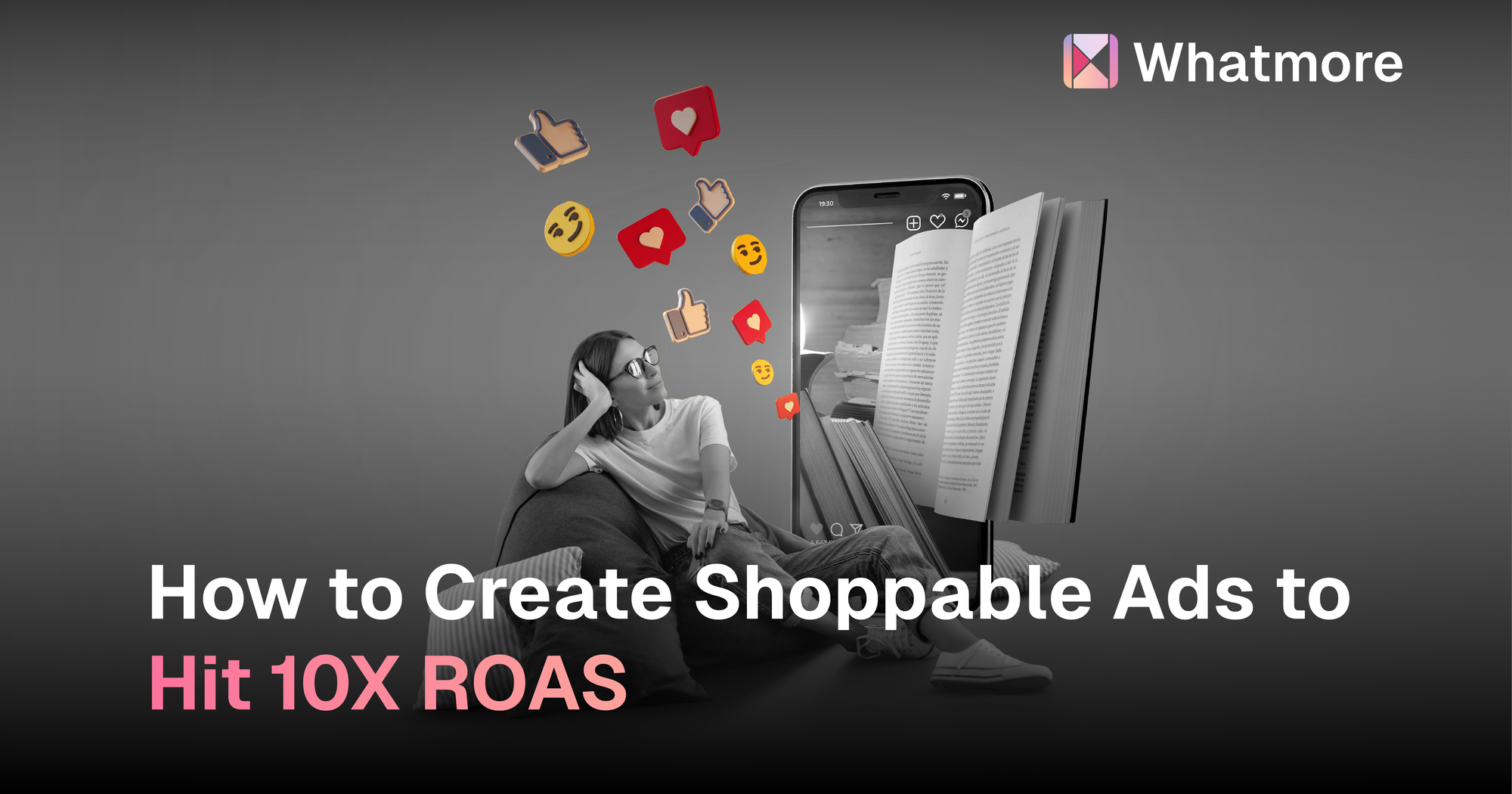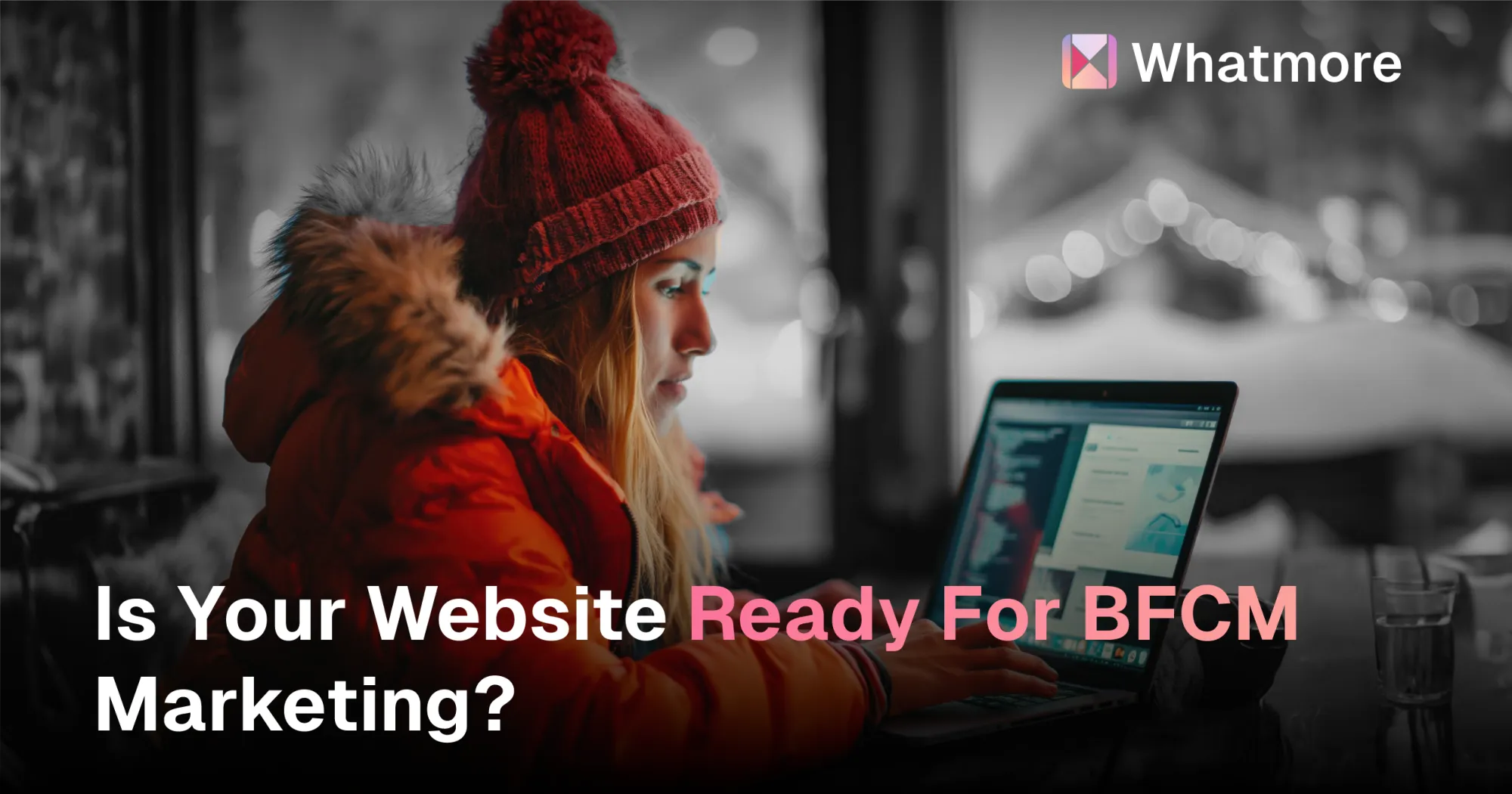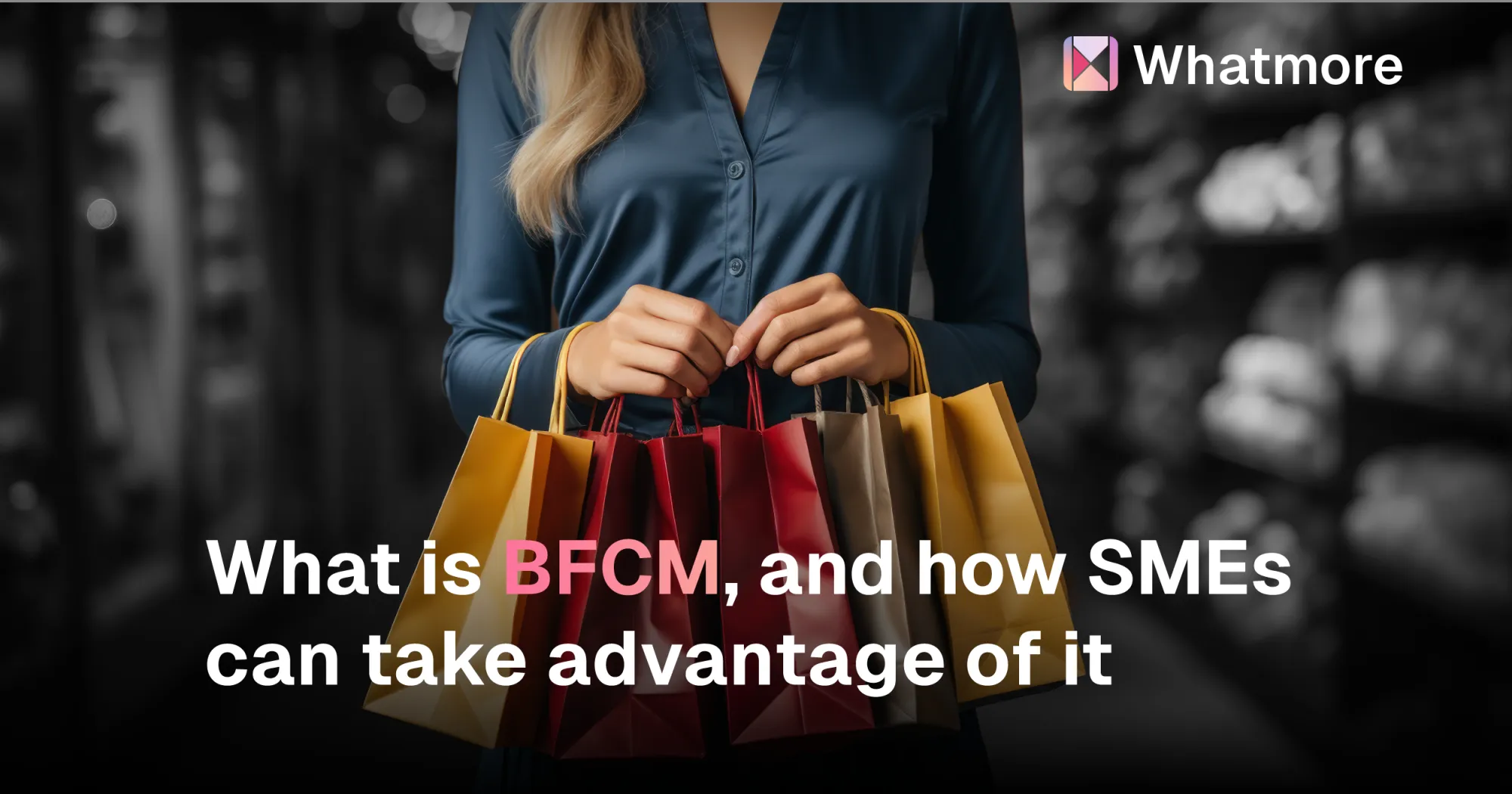What if your ads could skip the usual steps and take customers straight to checkout? Shoppable ads do just that—turning casual browsers into buyers without the hassle of extra clicks, website redirects, or abandoned carts. Instead of losing potential customers as they navigate multiple steps, you can keep them engaged and let them buy directly within the ad.
What are shoppable ads?
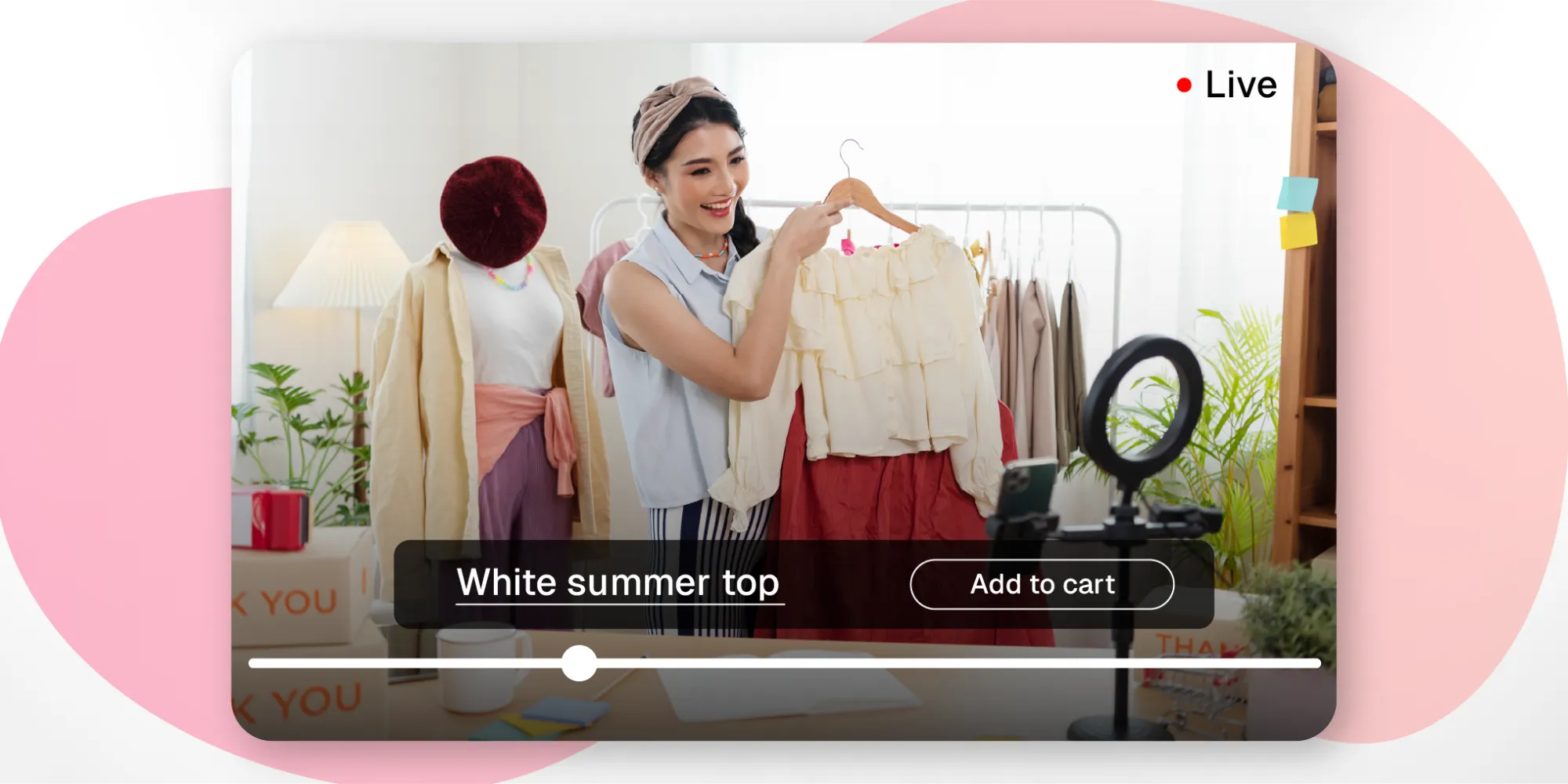
Shoppable ads are a type of online advertisement that allows customers to make purchases directly from the ad itself. Instead of redirecting users to a website or product page, these ads make it as easy as a few clicks to purchase. You can find them on platforms like Instagram, Facebook, Pinterest, TikTok, and even Google, where customers can browse and buy products straight from the ad.
Traditionally, users see the ad, click through to a landing page or product page, browse for more details, add the product to their cart, and then finally proceed to checkout. Each of these steps introduces friction, and potential buyers drop off at various points.
The biggest drop-offs usually happen right after the click-through, where users might bounce due to slow-loading pages, overwhelming navigation, or simply losing interest. Cart abandonment is another major issue—shoppers often reconsider their purchase at checkout, especially if the process is long or complicated.
Shoppable ads remove most of these extra steps by turning the ad itself into a mini-storefront. With products directly linked inside the ad, customers can shop without leaving the platform. By cutting out unnecessary steps, shoppable ads help capture impulse purchases and significantly improve conversion rates, driving better results for your business.
The benefits of shoppable ads for your e-commerce business

1. Reduced friction in the buying process
Shoppable ads eliminate the need for users to leave the platform or website to make a purchase. By allowing customers to buy directly within the ad, the typical drop-offs caused by extra clicks, slow load times, or complicated navigation are reduced, resulting in higher conversion rates.
One of the biggest reasons for drop-offs in traditional ads is the need to send users away from the platform they’re on. For example, if someone is scrolling through Instagram and clicks on an ad, they might be taken to a website that’s slow or difficult to navigate, causing them to lose interest and leave. With shoppable ads, customers stay where they were, maintaining a smooth experience from discovery to purchase.
2. Higher conversion rates
Because customers can buy immediately without moving through multiple steps and pages, shoppable ads reduce abandonment rates and increase the chances of completing a purchase.
Shoppable ads tap into the human desire for instant gratification. When customers see something they like, they can act on their impulse and buy it instantly. Shoppable ads allow consumers to complete their purchase in the moment of peak interest, removing the delays and distractions that often cause them to lose motivation to follow through with the purchase later.
3. Reduced cart abandonment
Cart abandonment is one of the biggest challenges eCommerce businesses face. In traditional online shopping, cart abandonment rates can be as high as 70% due to various factors like long checkout processes, unexpected shipping costs, or simply a lack of customer commitment.
Platforms like Instagram and Facebook often store user data such as payment methods and shipping addresses. When a customer is ready to purchase through a shoppable ad, these platforms can auto-fill the necessary details, significantly reducing the time spent during checkout. The fewer fields a customer has to fill out manually, the less likely they are to abandon the cart.
4. Better engagement
Shoppable ads are designed to increase engagement by making the shopping experience interactive, visual, and action-oriented. They allow users to interact directly with products, browse through options, and make purchases without leaving the platform. By leveraging personalized recommendations, social proof, influencer marketing, and immersive content, shoppable ads not only capture attention but also encourage deeper interaction.
By creating shoppable video content with engaging stories, tutorials, or even behind-the-scenes looks, brands can create an engaging narrative around their products.
5. Improved ROAS
Platforms like Facebook and Instagram offer robust ad attribution tools that help you track and measure the performance of shoppable ads. These tools provide detailed insights into how each ad contributes to your overall sales, giving you a clearer understanding of where your money is being well-spent.
Shoppable ads are a powerful tool for improving ROAS because they simplify the customer journey, engage users more effectively, and target the right audiences with precision. By reducing cart abandonment, increasing conversion rates, and optimizing for mobile users, shoppable ads drive more revenue from each ad dollar spent.
Shoppable ads can have personalized content, target warm leads, and capitalize on impulse purchases to ensure that your ad budget is used efficiently, leading to a higher return on ad spend and better overall performance for your campaigns.
How to create shoppable ads that convert
Creating shoppable ads that convert requires strategic planning, creative execution, and platform-specific optimization. In addition to social media and ad platforms, your own website can also serve as a platform for shoppable ads. Integrating shoppable features directly into your website can drive conversions from users who are already browsing your products. Here’s a step-by-step guide on how to create shoppable ads that not only attract attention but also drive conversions:
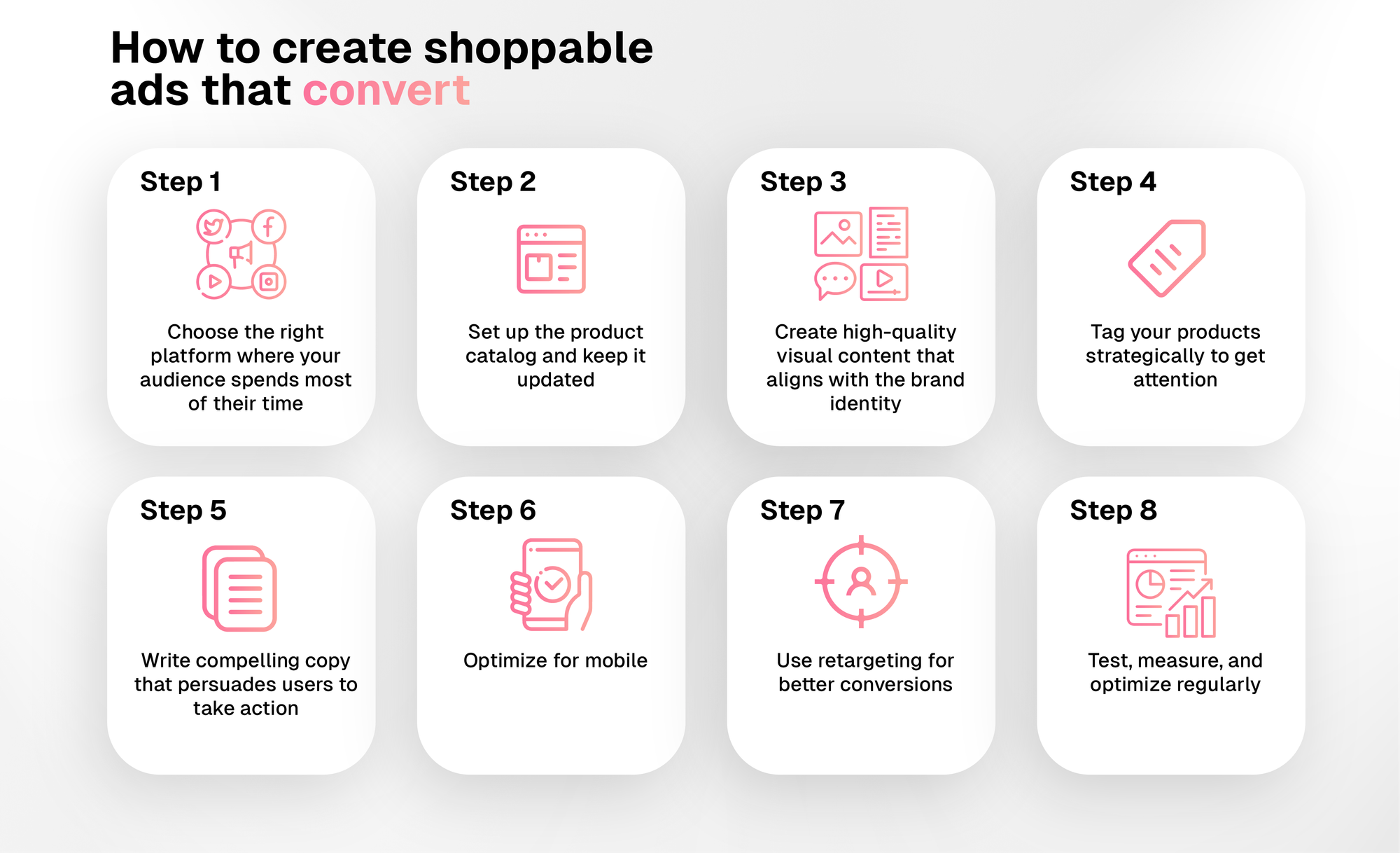
1. Choose the right platform
The first step in creating successful shoppable ads is choosing the right platform based on where your target audience spends most of their time. Here are some of the most popular platforms for shoppable ads:
- Instagram & Facebook: Great for reaching a broad audience and creating visual content, such as lifestyle images and influencer collaborations.
- Pinterest: Ideal for brands in fashion, home decor, or DIY, where users are looking for inspiration and discovery.
- Your own website: If your website is already attracting a significant amount of traffic, integrating shoppable features like product carousels, shoppable videos, or interactive banners can enhance the user experience.
- TikTok: Perfect for engaging younger, Gen Z audiences with short-form, fun, and relatable video content.
- Google Shopping Ads: Great for product-specific searches and capitalizing on intent-based purchases.
Tip: Start with one platform, test your shoppable ads, and scale to other platforms as you gather better insights.
2. Set up your product catalog
It is important to sync your product catalog with the advertising platform. Most platforms, like Instagram, Facebook, and Pinterest, allow you to connect your online store’s product catalog directly to their systems.
- Ensure your product catalog is up to date with high-quality images, accurate descriptions, pricing, and availability.
- Organize your products into collections (e.g., "New Arrivals," "Bestsellers") to make tagging easier and more effective.
Tip: Regularly check and update your product catalog to ensure it reflects your current inventory.
3. Create high-quality visual content
Whether you’re using images, carousel ads, or videos, make sure your content aligns with your brand identity and is tailored to your audience’s preferences.
- Use lifestyle imagery that shows your products in real-world settings, helping users visualize how they would use or wear them.
- For fashion or beauty products, partner with influencers or use user-generated content (UGC) to showcase your products more authentically.
- In video ads, include demonstrations or tutorials to provide added value and show how the product works.
Tip: Invest in professional photography or videography to ensure your visuals stand out in a crowded feed.
4. Tag your products strategically
In shoppable ads, you can tag products directly in the image or video, allowing users to click to learn more or purchase. Tagging products strategically is crucial for guiding the viewer’s attention toward the items you want to sell most.
- Limit the number of product tags: Avoid overwhelming users with too many options. Focus on your top-performing or most relevant products for the campaign.
- Tag key items in lifestyle photos: Instead of showing just the product itself, display the product in a real-world scenario and tag it within that setting (e.g., tagging a pair of shoes in a styled outfit).
- Use product collections: If you have multiple products that go well with each other, consider using carousel or collection formats where each frame highlights a different product or look.
Tip: Highlight your bestsellers or new arrivals to capture immediate interest.
5. Write compelling copy
While visuals are crucial, copywriting plays a significant role in grabbing attention and persuading users to take action. Your captions, headlines, and product descriptions should be clear, concise, and focused on your audience’s pain points and desires.
- Highlight key benefits: Mention why the product is unique or useful, whether it’s a feature, material, or limited-time offer.
- Use urgency: Phrases like “Limited Stock” or “Only Available Today” can encourage impulse buying.
- Include a clear call to action (CTA): Use action-oriented CTAs like “Click to Shop” “Buy Today,” or “Tap to Buy” to direct users toward the purchase.
Tip: Keep the tone conversational and engaging. Tailor your copy to match the voice and preferences of your target audience.
6. Optimize for mobile
Most of the users engage with shoppable ads on mobile devices, so it’s essential to optimize your ads for mobile-first experiences.
- Use vertical or square formats for images and videos to ensure they display well on mobile feeds.
- Ensure your load times are fast, as users are more likely to abandon slow-loading ads or product pages.
- Test your ads on various mobile devices to confirm they are easy to navigate and look polished.
Tip: Since mobile users are often multitasking, keep your content short, visually compelling, and easy to act on.
7. Use retargeting for better conversions
Retargeting is a powerful strategy that involves showing shoppable ads to users who have already interacted with your brand—such as visiting your website or abandoning their cart. Since these users are already familiar with your brand, they’re more likely to convert with a well-placed shoppable ad.
- Target users who have viewed specific products or engaged with previous ads but haven’t made a purchase.
- Retarget cart abandoners with personalized ads that include the products they left behind, offering a discount or reminder.
Tip: Use dynamic ads to automatically show users products they have browsed or added to their cart, increasing relevance and conversion rates.
8. Test, measure, and optimize
Once your shoppable ads are live, regularly monitor their performance and make adjustments as needed. Use platform analytics to track key metrics like click-through rates (CTR), conversion rates, and ROAS.
- A/B test different versions of your ads by changing elements such as imagery, copy, CTAs, and product tags to see which variations perform better.
- Optimize your targeting, ensuring you’re reaching the most relevant audience for each campaign.
- Identify which products or collections are driving the most conversions and focus on them in future campaigns.
Tip: Continually test new creative formats and messaging to find the optimal combination that maximizes conversions and ROAS.
Shoppable ads examples to inspire your campaigns
1. Ted Baker’s “Mission Impeccable” interactive film
In 2016, Ted Baker teamed up with renowned filmmaker Guy Ritchie to produce a shoppable, spy-themed interactive video called "Mission Impeccable."
Ted Baker's Mission Impeccable Shoppable Video Film
The stylish, cinematic short film allowed viewers to click on various items of clothing and accessories worn by the characters, providing more information about each item and letting them buy them directly from the video. It was gamified, where viewers could unlock hidden content, adding an element of entertainment that went beyond traditional advertising.
The campaign was promoted across multiple social media platforms, including Instagram, Facebook, and YouTube, which helped amplify its reach and drive more engagement.
Results:
- Increased engagement: The gamification and shoppable features led to a significant increase in time spent on the content, keeping viewers engaged for longer.
- Boost in sales: The campaign led to a 26.5% increase in sales of featured items, contributing to total revenue growth, which reached £321.9 million by the end of the campaign.
This campaign is an excellent example of how shoppable videos can transform traditional advertising into an immersive experience, engaging consumers while simultaneously driving sales.
Ted Baker’s "Mission Impeccable" set a new standard for creative eCommerce, combining storytelling with seamless shopping to turn passive viewers into active customers.
2. H&M – shoppable instagram feed
H&M recognized the potential of their 38 million Instagram followers and changed their entire feed into a shoppable experience. H&M made it super easy for their Instagram followers to shop by turning their posts into shoppable ones. Now, users could scroll through their feed, tap on a product they liked, and buy it right there—without leaving the app or interrupting their browsing.
With stunning visuals and high-quality product images, users could easily tap on their favorite items and buy them right away—without ever leaving Instagram. This turned H&M’s Instagram from just an inspiration feed into a place where you could actually shop, making the whole experience super smooth and convenient.
Results:
- Improved engagement: The shoppable format encouraged more interaction with posts, as users could easily purchase what they liked.
- Increased sales: The seamless experience reduced friction in the shopping journey, making it easier for customers to buy products they found on Instagram.
H&M leveraged Instagram’s shopping features to turn their massive following into loyal customers through shoppable content.
3. Lovechild by Masaba
Shoppable ad by Lovechild by Masaba helped engage viewers
Lovechild by Masaba launched a series of shoppable videos designed to increase customer engagement. They used interactive videos where viewers could simply click on the products shown in the video to explore more details and make a purchase, all without leaving the video platform. The goal was to create a smooth, effortless shopping experience that moved people from browsing to buying in just a few clicks.
The videos were super engaging with dynamic visuals and easy-to-use call-to-action buttons, encouraging instant shopping with no extra navigation needed. By using WhatMore.ai’s shoppable video technology, Lovechild personalized the experience for their fashion-savvy audience, making the content both engaging and highly interactive.
Results:
- Increased engagement rate: The campaign significantly boosted Lovechild’s engagement rate, increasing user interaction with the video by 41%. This jump in engagement was driven by the interactive nature of the shoppable elements, which kept viewers engaged longer and prompted more direct actions.
- Seamless shopping experience: The shoppable video format removed friction from the buying process, leading to a smoother and more intuitive shopping experience for users.
Lovechild’s success with shoppable ads shows how shoppable videos can drive engagement and conversion by making the buying process more accessible and interactive, helping brands connect with customers in an engaging, user-friendly format.
4. IKEA’s “Bedroom Habitats”
IKEA, known for its innovative marketing, launched a shoppable interactive video called "Bedroom Habitats," designed to help consumers visualize how their bedroom could be transformed using IKEA products. The video was crafted with clever narration and highlighted IKEA’s wide range of bedroom furniture and decor items.
Through interactive hotspots, viewers could hover over or click on different products in the video to learn more about each item. The video created an immersive experience, allowing customers to explore the products in a natural setting, helping them picture how IKEA’s solutions would fit into their own homes. The ad made it super easy to go from just being inspired to actually making a purchase by building the shopping options right into the video itself.
Results:
- The campaign saw impressive engagement, with 50% of product hotspots clicked by viewers, showing that people weren't just watching the video—they were actively exploring and thinking about the products.
By making the process simpler and more interactive, IKEA’s “Bedroom Habitats” campaign made shopping more fun using shoppable videos, increasing engagement and highlighting their value for converting viewers into customers.
5. Missoni
Missoni, the iconic Italian fashion brand known for its vibrant knitwear, teamed up with Adidas for a limited-edition collection of performance shoes and sports apparel. To promote this collection, Missoni launched a shoppable video campaign that allowed viewers to interact with the products while watching a video of models showing the apparel.
This allowed users to discover more about the products and purchase them directly through Missoni’s eCommerce store or Instagram ads. The video gave shoppers an interactive, immersive experience that mixed Missoni’s stylish vibes with Adidas' focus on performance.
Results:
- The shoppable video achieved a 38% engagement rate, meaning a lot of viewers interacted with the video’s shoppable elements.
- It also saw a 15% click-through rate (CTR), which is notably higher than industry standards for traditional video ads.
By combining fashion, performance, and interactivity, Missoni successfully created a highly engaging shoppable experience that brought the limited-edition collection to life and encouraged viewers to explore and purchase in real-time. This campaign shows how videos can make the shopping experience more fun and engaging, leading to higher user interaction and more sales.
6. Milton
Unboxing shoppable ads by Milton tells viewers exactly what to expect when they buy something from them
Milton, a well-known brand for kitchenware and household items, used shoppable videos to significantly reduce returns and improve the shopping experience. By adding clickable product tags into their videos, Milton allowed viewers to directly buy products if they liked them during their unboxing or other videos.
They highlighted the features and benefits of Milton’s products in a real-world setting. By making the shopping process more intuitive and reducing the number of steps to purchase, Milton increased conversions and kept users engaged longer.
Results:
- 450% increase in add-to-cart actions: Milton's use of shoppable video technology resulted in a remarkable 450% boost in add-to-cart rates compared to traditional static ads.
- Increased conversion rate: The combination of interactive content and reduced friction in the shopping process led to a higher conversion rate, as users could quickly make purchasing decisions while remaining engaged with the content.
By integrating product interactions directly within the shoppable video, the brand was able to capture user attention and streamline the path to purchase, resulting in a growth in add-to-cart instances.
7. Pandora
Pandora, a globally recognized jewelry brand, embraced the shoppable video format to enhance customer engagement and simplify the shopping journey. One of their standout campaigns, titled "An Interactive Experience," featured an interactive quiz that helped guide consumers toward personalized product recommendations based on their preferences. This added layer of interactivity and personalization not only engaged users but also collected valuable data about their preferences to tailor future marketing efforts.
Results:
- Increased engagement: The interactive quiz and shoppable video format led to a 17% increase in click-through rates and higher conversion rates compared to their traditional video ads.
- Sales growth: The campaign drove a 12% growth in online sales, as it allowed customers to move from browsing to purchasing without leaving the video, reducing friction.
Pandora’s campaign highlights how shoppable videos can not only enhance engagement but also drive sales by offering a more interactive and personalized shopping experience.
8. EKAM
EKAM, a luxury home fragrance brand, sped up the shopping process on their website by using shoppable videos. They added clickable links to the products featured in their videos, letting customers easily learn more and add items to their cart without leaving the video.
The videos showed how the fragrances could enhance different spaces, helping shoppers picture them in their own homes. By making it easy to shop directly from the video, EKAM cut down the steps it took to buy and kept customers engaged, making their decision to purchase much quicker.
Results:
- 60% faster buying process: EKAM successfully reduced the overall time it took for customers to complete a purchase on their website by 60%.
- Increased conversions: The ease of adding products to the cart and checking out without interrupting the shopping flow contributed to a higher conversion rate, as customers were less likely to abandon their cart or leave the site.
By reducing friction, EKAM was able to create a more seamless and engaging shopping journey, which directly contributed to higher sales and faster checkouts.
9. Beauty By Bie
Beauty By Bie, a skincare and beauty brand, used shoppable videos to enhance the customer shopping experience and drive higher sales. By embedding clickable links directly into their videos, the brand allowed viewers to explore and purchase products as they watched beauty tutorials and product demos. The interactive elements made it easy for users to learn more about the products, add them to their cart, and complete the purchase without leaving the video.
Beauty By Bie also highlighted key skincare routines in their videos, showcasing how multiple products work together, which helped raise average order value.
Results:
- Within just 30 days, the integration of shoppable videos led to a 12% boost in AOV. Customers were more inclined to purchase multiple products as they engaged with curated skincare routines presented in the videos.
- Enhanced customer engagement: The shoppable videos created a more engaging experience, making it easier for customers to browse, learn, and shop all at once.
By simplifying product discovery and encouraging customers to buy complementary products, Beauty By Bie saw immediate growth in customer spending and overall engagement.
10. Deconstruct’s Shoppable Video Campaign
Deconstruct, a skincare brand, used shoppable videos to simplify the buying process by allowing users to directly interact with the products featured in their tutorials. Customers could instantly click on products in the video, view more details, and make purchases without navigating away, creating a seamless shopping experience.
Results:
- Achieved an 11.26% conversion rate, showcasing the effectiveness of integrating interactive elements in video content.
Tips for optimizing ROAS for shoppable ads
- Target high-value customers by focusing on those with high lifetime value (LTV) and use upselling and cross-selling of the products that work well together to increase order value.
- Exclude low-intent audiences and focus on retargeting warm leads who have shown interest but haven't converted yet.
- Create lookalike audiences based on your best customers to reach people who are more likely to convert.
- Let the platform choose the best-performing spots for your ads, and remove underperforming placements to avoid wasting budget.
- Set specific ROAS goals and adjust bids manually or use automated bidding strategies to optimize for conversions while meeting your target ROAS.
- Test and rotate creatives frequently to avoid ad fatigue and keep your audience engaged with fresh content.
- Run ads during peak times when your audience is most active and likely to convert, and pause ads during low-converting periods to save your budget.
- Maintain an accurate product feed with up-to-date inventory, pricing, and high-quality images to improve conversion rates and reduce bounces due to bad experience.
- Increase average order value (AOV) by offering bundles, promoting complementary products, or setting free shipping thresholds.
- Use dynamic product ads for retargeting to show relevant products based on a user’s browsing or cart activity, encouraging them to complete a purchase.
- Optimize for mobile-first shoppers by ensuring a seamless mobile checkout experience and using mobile-preferred ad formats like vertical videos.
- Eliminate poor-performing products from your ads and focus on promoting top-selling, high-margin products to maximize profitability.
- Use social proof by incorporating customer reviews and highlighting popular products in your ads to build trust and increase conversions.
Wrapping Up
Shoppable ads are a game-changer for eCommerce businesses looking to simplify the customer journey and hike up the ROAS. By making it easier for customers to purchase your products without ever leaving the platform, you reduce friction and drive more sales.
Get started with shoppable ads with Whatmore.ai—sync up your catalog, craft a killer ad, and watch your ROAS soar!
